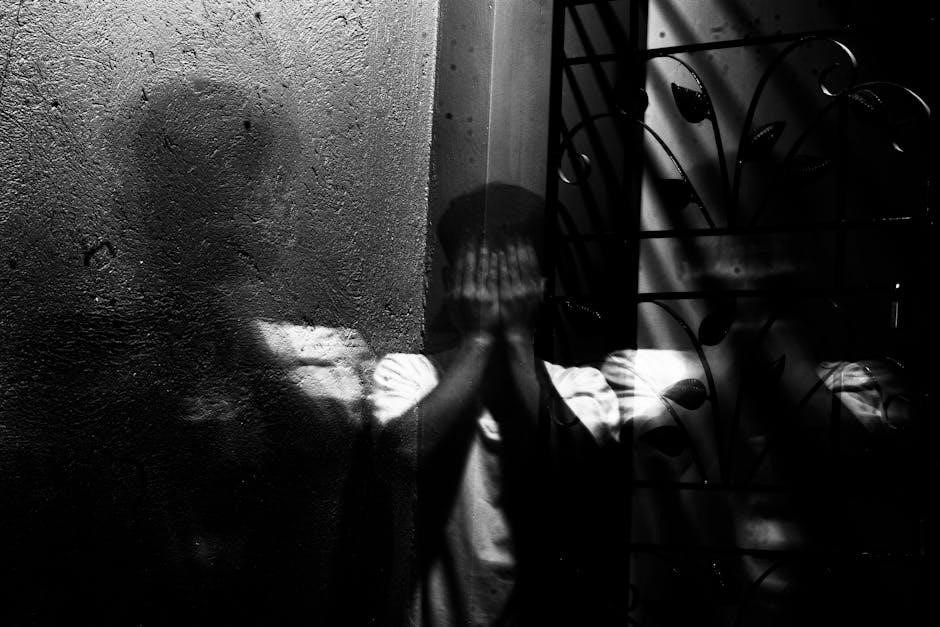Edward Albee, a Pulitzer Prize-winning playwright, debuted Who’s Afraid of Virginia Woolf? in 1962, a groundbreaking drama exploring marriage, illusion, and reality through dark humor and intense dialogue.
1.1 Biography of Edward Albee
Edward Albee, born on March 12, 1928, in Washington, D.C., was a renowned American playwright and a key figure in the Theatre of the Absurd movement. Adopted by wealthy parents, Albee’s early life was marked by a strained relationship with his family, influencing his later work. He attended various schools but never graduated, instead pursuing a career in writing. Albee’s breakthrough came with Who’s Afraid of Virginia Woolf? in 1962, which earned him critical acclaim and a Tony Award. His plays often explored themes of illusion, reality, and the dysfunction of American society. Albee won three Pulitzer Prizes and remained a significant voice in modern theater until his death on September 16, 2016.

1.2 Historical Context of the Play

Who’s Afraid of Virginia Woolf? premiered in 1962, a time of cultural and political upheaval in America. The play reflected the era’s shifting values, probing themes of marriage, illusion, and reality. It challenged traditional gender roles and societal norms, resonating with the emerging feminist movement and the civil rights era. Albee’s work was groundbreaking, pushing boundaries with its explicit language and dark humor. The play’s debut coincided with a growing skepticism of American ideals, making it a symbol of theatrical rebellion. Its success marked a turning point in modern theater, influencing future playwrights and cementing its place as a landmark of 20th-century drama.

Plot Summary of “Who’s Afraid of Virginia Woolf?”
The play revolves around a dysfunctional marriage between Martha and George, professors who engage in mind games with guests Nick and Honey, blurring reality and illusion.
2.1 Setting and Characters

The play is set in the home of Martha and George, professors at a small New England college, following a faculty party. The intimate setting amplifies the tension between the characters. Martha, a dominant and manipulative woman, and George, her passive-aggressive husband, engage in psychological warfare. Their guests, Nick, a young biology professor, and Honey, his naive and fragile wife, become entangled in their toxic games. The setting confines the characters, heightening the emotional intensity and forcing them to confront their illusions and realities. The four characters represent flawed humanity, each hiding behind masks of deception and societal expectations;
2.2 Key Events and Themes

The play unfolds through a series of mind games and emotional confrontations. Martha and George’s relationship is revealed through their constant verbal sparring and the illusion of their son, a fictional construct masking their infertility. The arrival of Nick and Honey introduces new dynamics, as Martha’s flirtation and George’s intellectual challenges disrupt the group. Themes of illusion vs. reality, marital dysfunction, and societal expectations dominate. The play’s climax strips away the characters’ facades, exposing raw truths and the disintegration of their emotional defenses. Albee’s masterful dialogue and pacing create a tense, unpredictable narrative that challenges conventional notions of identity and relationships.
Analysis of Main Characters
Martha, George, Honey, and Nick are central to the play, each representing complex dynamics. Martha’s dominance contrasts George’s passive-aggressive nature, while Honey and Nick symbolize youthful naivety and ambition.
3.1 Martha and George: Their Relationship Dynamics
Martha and George’s relationship is a central element of the play, marked by a toxic mix of love, resentment, and psychological warfare. Their interactions are filled with biting humor, manipulation, and emotional brutality, revealing a deep-seated pain beneath their dysfunctional marriage. Martha’s dominant and assertive nature clashes with George’s passive-aggressive demeanor, creating a volatile dynamic. Through their relentless mind games, Albee exposes the fragility of their relationship, built on illusions and shared delusions. Their constant battle for power and control underscores the themes of illusion vs. reality, while their interactions with Honey and Nick further highlight the cracks in their marriage. This complex interplay defines the play’s emotional core and societal critique.
3.2 Honey and Nick: Their Roles in the Play
Honey and Nick, a young couple invited to George and Martha’s home, serve as both participants and observers in the dysfunctional dynamics. Their presence amplifies the tension, as Martha and George use them to further their psychological games. Honey’s naivety and Nick’s ambition contrast with the older couple’s cynicism, highlighting the generational divide. Through their interactions, Albee critiques societal expectations and the facade of perfection. Honey’s eventual breakdown and Nick’s complicity reveal their own vulnerabilities, making them pawns in Martha and George’s twisted rituals. Their roles underscore the play’s exploration of illusion, reality, and the masks people wear to hide their insecurities.

Themes and Motifs
Central themes include illusion vs. reality, marital dysfunction, and themasking of insecurities through psychological games and alcohol, reflecting societal critiques of human relationships and existential truths.
4;1 Illusion vs. Reality
Edward Albee’s Who’s Afraid of Virginia Woolf? masterfully explores the tension between illusion and reality, as characters Martha and George construct fantasies to escape their disillusioned lives. Their games of deception, fueled by alcohol and emotional manipulation, blur the lines between truth and fabrication. The play critiques societal norms by exposing how individuals hide behind illusions to avoid confronting their insecurities and failures. This theme is central to the drama, as the characters’ delusions crumble, revealing raw, unvarnished truths about marriage, identity, and the human condition. Albee’s portrayal of this struggle remains a powerful commentary on the fragility of human relationships and the masks people wear to cope with reality.
4.2 Gender Roles and Marriage
Edward Albee’s Who’s Afraid of Virginia Woolf? critically examines gender roles and the institution of marriage through the volatile relationship of Martha and George. The play satirizes societal expectations of masculinity and femininity, as Martha embodies a dominant, assertive figure, while George often appears passive, challenging traditional norms. Their marriage, marked by emotional warfare, exposes the cracks in the idealized notion of marital harmony. Meanwhile, Honey and Nick represent contrasting roles, with Honey’s naivety and Nick’s ambition highlighting societal pressures on women and men. The play’s portrayal of these dynamics underscores the tension between individual identity and societal expectations, offering a bleak yet thought-provoking critique of marriage and gender roles in the 1960s.

Cultural and Historical Impact
Edward Albee’s Who’s Afraid of Virginia Woolf? revolutionized modern theater, challenging traditional storytelling and exploring themes of illusion and reality. Its bold critique of marriage and societal norms resonated with the cultural shifts of the 1960s, influencing both stage and screen adaptations. The play’s impact endures, making it a timeless classic in American drama.

5.1 Stage and Screen Adaptations
Edward Albee’s Who’s Afraid of Virginia Woolf? has been adapted into multiple stage productions and a notable 1966 film starring Elizabeth Taylor and Richard Burton. The play’s intense dialogue and complex characters translate seamlessly to both mediums, maintaining its emotional depth. The film adaptation won several Academy Awards, further cementing the play’s cultural significance. Additionally, various stage revivals, such as the 2023 production featuring Tracy Letts and Amy Morton, continue to draw audiences, showcasing the timeless appeal of Albee’s work. These adaptations have played a crucial role in popularizing the play and ensuring its enduring influence on modern theater and cinema.
5.2 Influence on Modern Theater
Who’s Afraid of Virginia Woolf? revolutionized modern theater by challenging traditional narrative structures and embracing absurdism. Albee’s exploration of illusion vs. reality and his bold portrayal of marital dysfunction influenced countless playwrights. The play’s dark humor and intense character dynamics raised the bar for dramatic writing, encouraging experimentation with dialogue and themes. Its success paved the way for absurdist and avant-garde works, reshaping the theatrical landscape. Today, it remains a benchmark for actors and directors, inspiring new interpretations and adaptations that continue to captivate audiences, ensuring Albee’s legacy as a pioneer in modern theater.

The Title’s Significance
The title, inspired by a song, symbolizes the dismantling of illusions, reflecting the play’s central theme of confronting harsh truths beneath societal facades.
6.1 Origin and Meaning
The title Who’s Afraid of Virginia Woolf? originates from a playful song, symbolizing the dismantling of illusions and societal facades. It reflects the play’s central theme of confronting harsh truths beneath polite veneers, as Martha and George’s toxic relationship exposes the cracks in their marriage and identities. The title encapsulates Albee’s exploration of reality versus illusion, challenging characters and audiences to confront uncomfortable truths. By invoking Virginia Woolf, a literary icon of depth and complexity, the title hints at the intellectual and emotional layers of the narrative, making it a powerful metaphor for the human struggle with authenticity and deception.

